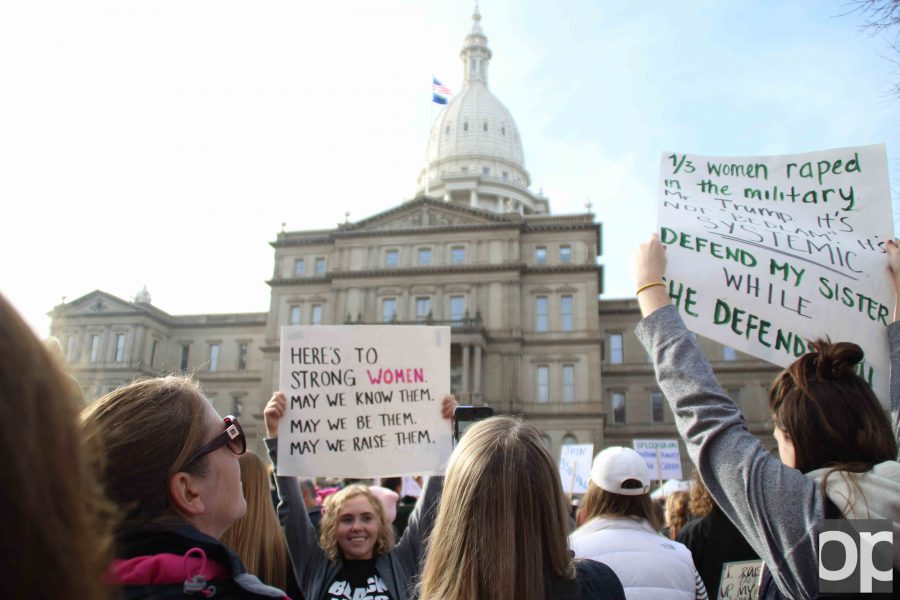Women’s March on Lansing rallies thousands in protest
Men and women came together in Michigan’s capital, Lansing, to march for women’s rights. It was part of one of the 600 sister marches organized after the march in D.C.
Over 8,000 people from all walks of life united for the Women’s March on Lansing, taking a stand against intolerance.
Held on Jan. 21, this sister event to the Women’s March on Washington took place on the steps and lawn of the State Capitol Building. It was one of more than 600 other marches held around the world, according to the Lansing State Journal.
A sea of women and men of different races and ages could be seen raising clever signs. There were children on their parents’ shoulders and a guy in a bear costume. The crowd grew so large that surrounding streets were shut down to accommodate the march.
The protesters gathered to voice their opinions on issues like women’s rights, health care and the Flint water crisis.
“The original idea for the march was in solidarity with the Women’s March on Washington and in response to the rash of hate and bias crimes that swept Michigan and the nation in November,” said Sarah Kathryn Eisenberg, a co-organizer of the March on Lansing. “Since that time, we have shifted to not just standing against bigotry and hatred, but standing for a Michigan that respects and protects all its citizens, that celebrates diversity and nurtures the human potential in each of us.”
In addition to a musical performance by the Sistrum Women’s Chorus, participants were fueled by the powerful words of various public leaders. This included Democratic candidate for governor Gretchen Whitmer, as well as Dr. Farha Abbasi from the Michigan Muslim Community Council.
The protesters used their vast personal experiences to voice ways to get involved and make a real difference.
Although the original plan was to march through the city, this became impossible due to cost, as organizers could not obtain the $5-million insurance coverage that was needed, according to MarchOnLansing.org.
Instead, they decided to make it a symbolic march, with people trekking to the State Capitol in protest.
Leading up to the rally, the event’s Facebook page received some trolling with inappropriate and even hostile comments. These were taken seriously and reported to the police for further investigation.
Eisenberg said it is essential to remember where hatred comes from.
“Those who would lash out at you, those who would silence you, only do so because they are afraid of what you are saying and doing,” she said. “They are afraid that somehow you threaten them, and they retaliate out of fear and ignorance. In responding to them, it is important to heed the words of Michelle Obama: ‘When they go low, we go high.’ Show them the mature, measured and respectful tone that demonstrates to them that you are neither afraid nor a threat.”
March attendees were able to stop by informational tables hosted by organizations like Planned Parenthood and Black Lives Matter.
“We wanted to give people the chance to see what was in their community and how they can help,” said Meg McElhone, another organizer of the March on Lansing.
The March on Lansing partnered with Women Organize Michigan, which puts on free inclusive summits across Michigan to discuss and advance progressive causes, according to its website.
The goal of these summits is to translate passion into specific action.
Women Organize Michigan’s website states: “Raising awareness is important. Cultivating outrage is important. These are the things that call people to action. But when it stops there, when your only action is sharing outrage and spreading information, we have failed to make any lasting changes.”
Courtney Bryson, a communication major at Oakland University, made the long haul to Washington, D.C. for its Women’s March.
“It was absolutely incredible and inspiring to be surrounded by so many people all fighting for social justice,” she said.
Bryson made it clear that she didn’t attend in protest against the country’s new president, but rather as a way to show elected officials that she will continue standing firm in her beliefs.
The values of the Women’s March on Washington stemmed from the belief that “Women’s rights are human rights and human rights are women’s rights,” as stated in its Guiding Vision and Definition of Principles, which goes on to include, “We believe Gender Justice is Racial Justice is Economic Justice.”
While organizers originally expected around 200,000 people, it is believed crowds grew to as many as half a million, according to The Washington Post.
“I’ll always remember this experience, and I think the march is creating conversations surrounding white feminism versus. intersectional feminism, and how we can all be more inclusive, considering there wasn’t a particularly overwhelming representation of trans women and people of color,” said Bryson. “The march definitely put me in check and reminded me of my own privilege and to use that to help others whenever possible.”
Eisenberg said it is especially important for young adults to get involved.
“It is vitally important to the health of our state and our nation that we as citizens take an active role in directing our lawmakers and advocating for our rights and the rights of our friends and neighbors,” she said. “Young people, even those who are too young to vote or unable to vote due to citizenship status, can have an enormous impact if they are willing to stand up and make their voices heard. They can shape the future they want for themselves and their communities.”
To continue forward, the Women’s March launched a new campaign called “10 Actions for the First 100 Days”. Every 10 days, the campaign will instruct followers to take a certain collective action.
The first action asks individuals to write a postcard to their senators regarding what matters most to them and how they plan to fight for it. For more information on the project, visit www.womensmarch.com/100/.
Eisenberg summed up the march, echoing a sentiment often attributed to Mahatma Gandhi:
“We all need to be the change we want to see in the world.”











